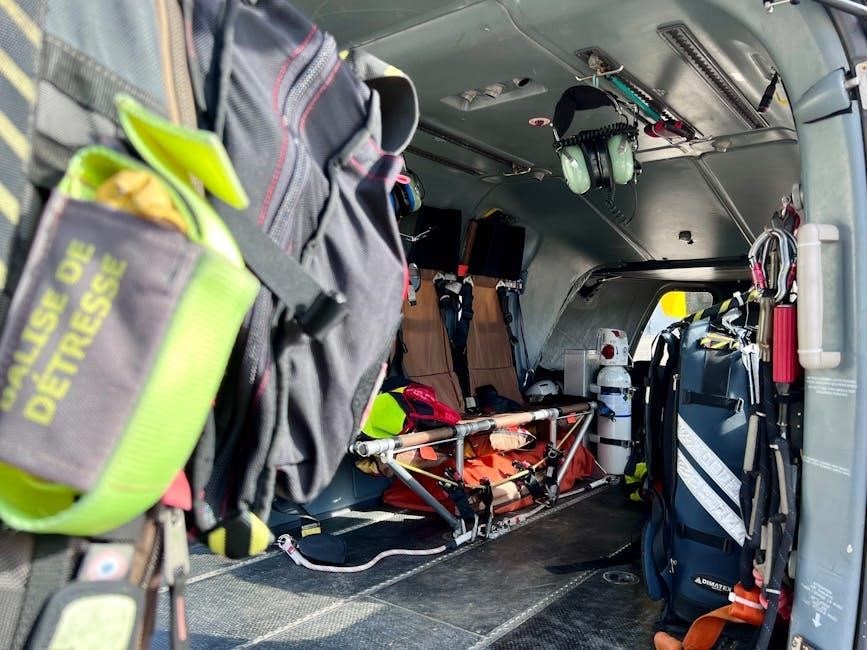non emergency medical transportation policies and procedures manual

Non-Emergency Medical Transportation (NEMT) refers to the safe and efficient transportation of patients who require medical care but do not need emergency services. This includes routine appointments, rehabilitation sessions, or non-urgent medical procedures. NEMT services are essential for ensuring access to healthcare for individuals with disabilities, chronic illnesses, or limited mobility.
A comprehensive policies and procedures manual is vital for NEMT providers to ensure compliance with regulatory standards, maintain patient safety, and streamline operations. It serves as a roadmap for delivering high-quality, efficient transportation services while addressing legal and operational requirements.
1.1 Definition and Scope of NEMT Services
Non-Emergency Medical Transportation (NEMT) services involve the safe and coordinated movement of patients who require medical attention but do not need emergency care. These services are designed for individuals with disabilities, chronic illnesses, or mobility challenges, ensuring they can access necessary healthcare appointments and treatments.
The scope of NEMT includes routine medical appointments, rehabilitation sessions, dialysis treatments, and non-urgent hospital visits. Transportation is typically provided using specialized vehicles, such as wheelchair-accessible vans or ambulatory vehicles, equipped to meet patients’ specific needs. NEMT services bridge gaps in healthcare access, enabling patients to maintain their health and well-being without relying on emergency systems.
1.2 Importance of a Comprehensive Policies and Procedures Manual
A comprehensive policies and procedures manual is crucial for Non-Emergency Medical Transportation (NEMT) providers to ensure operational efficiency, compliance with regulations, and patient safety. It outlines clear guidelines for driver qualifications, vehicle maintenance, and incident reporting, minimizing risks and legal liabilities. The manual also serves as a training tool for staff, ensuring consistency in service delivery and adherence to industry standards. By establishing a framework for decision-making and accountability, it fosters trust and confidence among patients, providers, and regulatory bodies, ultimately enhancing the quality of care and service delivery.

Regulatory Framework Governing NEMT
NEMT operations are governed by federal, state, and local regulations ensuring compliance with safety, patient rights, and service delivery standards. These frameworks dictate operational practices, licensing requirements, and documentation protocols to ensure accountability and quality care.
2.1 Federal Regulations and Guidelines
Federal regulations play a crucial role in shaping NEMT operations. The Department of Health and Human Services (HHS) and the Centers for Medicare and Medicaid Services (CMS) set guidelines for reimbursement, patient eligibility, and service standards. These regulations ensure consistency and compliance across states, with a focus on patient safety and quality care. Additionally, the Occupational Safety and Health Administration (OSHA) provides standards for workplace safety, while the Americans with Disabilities Act (ADA) mandates accessibility requirements for NEMT vehicles. Adherence to these federal guidelines is essential for providers to maintain certification and funding eligibility.
2.2 State-Specific Laws and Requirements
State-specific laws and requirements for NEMT vary significantly, with each state establishing its own licensing, operational, and compliance standards. These laws often dictate vehicle inspection criteria, driver qualifications, and insurance mandates. Additionally, states may impose specific patient transportation protocols and documentation requirements. NEMT providers must stay informed about these regulations, as they often differ from federal guidelines. Compliance with state laws is crucial for maintaining operational legitimacy and avoiding penalties. Regular updates to policies and procedures are necessary to align with evolving state-specific requirements, ensuring seamless service delivery and adherence to local governance.
2.3 Local Ordinances and Compliance Standards
Local ordinances and compliance standards add another layer of regulation for NEMT providers, often requiring adherence to specific city or county rules. These may include permits for operation, vehicle parking restrictions, and emission standards. Compliance with local zoning laws and business licensing is also essential. Additionally, some jurisdictions enforce specific safety protocols or equipment requirements for NEMT vehicles. Staying updated on these local regulations ensures uninterrupted service delivery and avoids legal complications. Regular audits and staff training on local compliance standards are crucial for maintaining operational integrity and public trust in NEMT services. Proactive engagement with local authorities helps navigate these requirements effectively.

Policies for NEMT Providers
Policies for NEMT providers outline operational standards, ensuring compliance with regulations, patient safety, and efficient service delivery. They guide driver conduct, vehicle maintenance, and emergency protocols, fostering accountability and reliability in transportation services.
3.1 Driver Qualifications and Training Requirements
Drivers must meet specific qualifications, including valid driver’s licenses, clean driving records, and background checks. They must complete training in patient handling, first aid, and emergency protocols. Annual recertification ensures compliance with safety and regulatory standards. Training programs cover vehicle operation, passenger assistance, and communication skills. Drivers are also educated on privacy policies and incident reporting procedures. Regular updates on new regulations and best practices are mandatory. These requirements ensure safe, professional, and reliable transportation services for patients. Non-compliance may result in disciplinary actions, emphasizing the importance of adhering to these standards.
3.2 Vehicle Safety and Maintenance Standards
Vehicles used for NEMT must meet rigorous safety and maintenance standards to ensure patient and driver well-being. Regular inspections are required to verify proper functioning of brakes, tires, and safety equipment. Maintenance schedules must follow manufacturer guidelines, with documentation kept for compliance. Vehicles must be equipped with first aid kits, fire extinguishers, and proper lighting. Annual inspections by certified mechanics are mandatory. Non-compliance with safety standards can result in service termination. Proper maintenance ensures reliable transportation, reduces risks, and maintains trust in the service provided.
3.3 Insurance and Liability Coverage
Insurance and liability coverage are critical components of NEMT operations. Providers must maintain adequate general liability insurance to cover accidents or injuries during transport. Medical malpractice insurance is also essential to protect against claims of improper patient care. Policies must comply with state and federal regulations, ensuring sufficient coverage for passengers, drivers, and third parties. Proper documentation of insurance policies is required, and annual reviews must be conducted to ensure coverage remains adequate. Failure to maintain proper insurance can result in penalties or loss of operating privileges. Adequate coverage safeguards both patients and providers, ensuring financial protection in case of unforeseen events.

Procedures for Service Delivery
Procedures for NEMT service delivery include transportation protocols, safety measures, and efficient scheduling. These ensure safe, timely, and respectful transport, adhering to guidelines and patient needs.
4.1 Scheduling and Dispatch Processes
Scheduling and dispatch processes are critical for efficient NEMT operations. These processes involve receiving and verifying transportation requests, prioritizing trips based on urgency, and assigning drivers. Automated systems or manual coordination ensure accurate trip assignments. Dispatchers must confirm driver availability, vehicle readiness, and route optimization. Real-time tracking and communication are essential to handle delays or changes. Clear documentation of scheduling and dispatch activities ensures transparency and accountability. Proper protocols minimize wait times and ensure patients reach destinations safely and on time, maintaining service quality and compliance with operational standards.
4.2 Patient Eligibility and Assessment Criteria
Patient eligibility for NEMT services is determined based on medical necessity and specific criteria. Generally, patients must have a valid medical need for transportation, such as a chronic illness, disability, or inability to drive themselves. Assessment criteria include evaluating the patient’s condition, mobility limitations, and requirement for assistance during transport. Insurance coverage and program guidelines also play a role in determining eligibility. A thorough assessment ensures appropriate service allocation, optimizing resource use while addressing individual patient needs. This process is essential for delivering equitable and efficient transportation services.
4.3 Transportation Protocols and Safety Measures
Transportation protocols for NEMT services emphasize patient safety and comfort. Drivers must follow pre- and post-trip inspections of vehicles, ensuring proper functioning of safety equipment. Patients are secured with appropriate restraints, and drivers are trained in safe lifting and handling techniques. Emergency communication devices are mandatory, and drivers must be prepared to handle medical emergencies during transit. Protocols also include maintaining a clean and hygienic environment within the vehicle. Adherence to these measures minimizes risks and ensures a safe, dignified transport experience for all patients, aligning with regulatory and quality care standards.

Patient Rights and Responsibilities
Patient rights include respect, dignity, and confidentiality of personal and medical information. Responsibilities involve providing accurate information and adhering to transport policies, ensuring a safe experience.
5.1 Patient Privacy and Confidentiality
Patient privacy and confidentiality are paramount in NEMT services. Providers must adhere to HIPAA standards, ensuring all personal and medical information remains secure. This includes limiting access to authorized personnel and using encrypted communication systems. Patients have the right to consent to the sharing of their information. Breaches of confidentiality are strictly prohibited and may result in legal consequences. Proper training for drivers and staff on privacy protocols is essential to uphold these standards and maintain trust with patients.
5.2 Informed Consent and Documentation
Informed consent is a critical aspect of NEMT services, ensuring patients understand and agree to the transportation and care provided. Patients must receive clear information about their rights, the nature of the service, and any associated risks. Written consent must be obtained prior to transport, with documentation maintained securely. Records should include consent forms, trip details, and any medical instructions. Compliance with HIPAA and state-specific regulations is essential to protect patient information. Proper documentation ensures accountability, transparency, and continuity of care, while also safeguarding providers against potential disputes or legal issues.
5.3 Patient Conduct During Transport
Patients are expected to behave appropriately during transport, following crew instructions to ensure safety and efficiency. This includes refraining from disruptive behavior, respecting crew members, and adhering to safety protocols. Patients must remain seated and use seatbelts when required. Unauthorized use of electronic devices or consumption of prohibited substances is strictly prohibited. Any misconduct may result in transport termination or reporting to authorities. Clear communication of expectations helps maintain a safe and respectful environment for all parties involved during the transport process. Compliance with these guidelines ensures a smooth and secure experience for both patients and NEMT staff.

Billing and Reimbursement Procedures
Billing and reimbursement for NEMT services require accurate documentation, including trip logs and medical necessity forms. Insurance verification and compliance with payment policies are essential for timely reimbursement.
6.1 Insurance Coverage and Payment Policies
Insurance coverage for NEMT services varies by provider and policy. Patients must verify eligibility before scheduling transport. Payment policies typically require pre-approval and proper documentation, such as medical necessity forms. Billing processes must comply with insurance guidelines to avoid denied claims. Providers should maintain detailed records, including trip logs and patient information, to facilitate reimbursement. Understanding insurance coverage and payment policies is crucial for minimizing delays and ensuring timely compensation for services rendered. Clear communication with insurers and patients helps streamline the billing process and reduces financial discrepancies. Compliance with all applicable regulations is essential for sustained operational efficiency.
6.2 Documentation Requirements for Billing
Accurate and comprehensive documentation is essential for billing in NEMT services. Required documents include detailed trip logs, patient demographic information, and medical necessity forms. Providers must maintain records of pickup and drop-off times, plus any relevant medical notes. Invoices should clearly outline services rendered, mileage, and fees. Compliance with HIPAA regulations is mandatory to protect patient privacy. Proper documentation ensures timely reimbursement and minimizes billing disputes. Incomplete or missing records can result in denied claims, emphasizing the importance of meticulous record-keeping. Organized files also facilitate audits and reviews, ensuring transparency and accountability in billing processes.
6.3 Appeals and Dispute Resolution Processes
NEMT providers must establish clear procedures for handling appeals and disputes regarding billing or service denials. Patients or providers may submit appeals in writing, detailing the dispute and supporting documentation. The appeals process should include a timeline for review and resolution. Disputes may involve insurance coverage, claim denials, or service eligibility. Designated personnel should review cases objectively, ensuring compliance with policies and regulations. If unresolved, disputes may escalate to higher authorities or external mediators. Transparent communication and timely resolution are critical to maintaining trust and operational integrity.

Incident Reporting and Management
Incidents must be documented and reviewed to prevent future occurrences. Drivers should report incidents promptly, and records must be maintained for compliance and improvement.
7.1 Types of Reportable Incidents
Reportable incidents in NEMT include vehicle accidents, medical emergencies during transport, patient injuries, or altercations. These incidents must be documented to ensure accountability and safety.
- Accidents involving NEMT vehicles or personnel.
- Medical emergencies requiring immediate intervention.
- Incidents involving patient or driver misconduct.
- Equipment failures or vehicle malfunctions.
Timely reporting and documentation are critical for investigations, improving safety protocols, and ensuring compliance with regulatory standards.
7.2 Incident Reporting Procedures
All incidents must be reported promptly to ensure accountability and safety. Drivers should notify dispatch immediately and complete an incident report form within 24 hours.

- Document incident details, including date, time, location, and parties involved.
- Include witness statements and any supporting evidence, such as photos or videos.
- Submit the report to the compliance or safety department for review and action.
Incident reports are critical for identifying trends, implementing corrective actions, and ensuring compliance with regulatory standards.
7.3 Incident Analysis and Corrective Actions
Following incident reporting, a thorough analysis is conducted to identify root causes and prevent future occurrences. Corrective actions are developed based on findings and implemented promptly.
- Root cause analysis to determine contributing factors.
- Development of preventive measures and updated protocols.
- Training or retraining of staff to address gaps.
- Monitoring of corrective actions to ensure effectiveness.
Documentation of analysis and actions is maintained for compliance and continuous improvement, ensuring accountability and enhanced patient safety.
Quality Assurance and Continuous Improvement
Quality assurance ensures NEMT services meet standardized benchmarks, while continuous improvement promotes ongoing enhancements. Regular monitoring, patient feedback, and performance evaluations drive service refinement and optimal care delivery.
- Monitoring service quality through audits and evaluations.
- Gathering patient and provider feedback for insights.
- Implementing improvements to enhance efficiency and patient satisfaction.
8.1 Monitoring and Evaluation of Services
Monitoring and evaluation are critical for ensuring NEMT services meet quality standards and patient needs. Regular audits, performance metrics, and patient feedback are essential tools for assessment. Data collection involves tracking on-time arrivals, vehicle maintenance compliance, and incident reports. These insights help identify gaps and areas for improvement, ensuring services remain efficient and patient-centric. Continuous oversight guarantees adherence to regulatory requirements and enhances overall service delivery. By analyzing trends and outcomes, providers can refine processes, optimize resources, and maintain high levels of care and satisfaction. Effective monitoring fosters accountability and drives sustainable quality improvement initiatives.
8.2 Feedback Mechanisms for Patients and Providers
Establishing robust feedback mechanisms ensures continuous improvement in NEMT services. Patients and providers can submit feedback through surveys, suggestion forms, or designated hotlines. This input helps identify service strengths, areas for improvement, and operational inefficiencies. Feedback is reviewed regularly to enhance patient satisfaction and service quality. Confidentiality is maintained to encourage honest responses. By implementing feedback-driven changes, NEMT providers demonstrate a commitment to excellence and patient-centered care. This iterative process fosters trust, accountability, and ongoing refinement of transportation services to better meet community needs and expectations.
8.3 Implementing Quality Improvement Initiatives
Implementing quality improvement initiatives is essential for enhancing NEMT services. These initiatives involve analyzing feedback, identifying gaps, and developing actionable steps to address them. Regular staff training, updated protocols, and technology integration are key components. Monitoring progress ensures sustained improvements. By fostering a culture of continuous improvement, NEMT providers can enhance patient care, operational efficiency, and compliance with regulatory standards. These efforts ultimately lead to better service delivery and higher patient satisfaction, ensuring the program remains effective and adaptable to evolving needs.

Emergency Preparedness and Response
Emergency preparedness ensures NEMT providers can respond effectively to unexpected situations. This includes having clear protocols for driver actions, communication strategies, and coordination with emergency services during crises.
9.1 Emergency Protocols for Drivers
Drivers must adhere to established emergency protocols, ensuring prompt and safe responses. These include immediate actions during incidents, clear communication procedures, and coordination with emergency services. Protocols outline steps for assessing situations, securing passenger safety, and providing basic first aid if trained. Drivers are also required to report incidents promptly, documenting details accurately. Regular training and drills ensure preparedness, aligning with regulatory standards and organizational policies; These protocols aim to minimize risks and ensure efficient handling of emergencies, maintaining passenger and driver safety as the top priority.
9.2 Communication Strategies During Emergencies
Effective communication is critical during emergencies in NEMT operations. Drivers must follow standardized protocols for alerting dispatch, notifying emergency services, and updating passengers. Clear, concise, and accurate information ensures timely assistance. Communication should include details about the incident, location, and passenger condition. Use of two-way radios, mobile apps, or emergency alert systems is recommended. Regular training on communication techniques ensures efficiency and clarity. Documentation of all communications is essential for incident reviews and compliance. These strategies aim to enhance coordination, reduce response times, and ensure passenger safety during critical situations. Regular drills reinforce these practices, preparing drivers for real-world scenarios.
9.3 Coordination with Emergency Services
Effective coordination with emergency services is essential for NEMT operations. Establishing clear relationships with local emergency medical services (EMS) ensures seamless integration during critical situations. NEMT providers must develop joint response plans, outlining roles and responsibilities. Communication channels should be pre-established to enable rapid information sharing. Drivers must be trained to collaborate with EMS teams, ensuring unified efforts during emergencies. Regular drills and joint training exercises enhance preparedness. Sharing real-time data, such as passenger conditions and vehicle locations, improves response efficiency. This coordination minimizes delays, enhances patient outcomes, and strengthens overall emergency response capabilities. Documentation of these interactions aids in post-incident reviews and continuous improvement.

Documentation and Record-Keeping
Accurate and secure documentation is critical for NEMT operations. Detailed records of patient transport, including trip details and medical information, must be maintained for compliance and audits.
10.1 Maintaining Patient Transport Records
Maintaining accurate and detailed patient transport records is essential for NEMT operations. These records should include patient demographics, trip details, pickup and drop-off locations, and any medical information relevant to the transportation. Documentation must be stored securely to comply with HIPAA regulations and ensure patient privacy. Additionally, records should be easily accessible for audits, billing purposes, and future reference. Consistent and thorough documentation helps in maintaining transparency, accountability, and high-quality service delivery in NEMT.
10.2 Record Retention and Storage Policies
Records related to NEMT services, including patient transport details and billing documentation, must be retained for a specified period as per regulatory requirements. Digital and physical records should be stored securely to prevent unauthorized access or data breaches. Policies should outline retention periods, storage methods, and procedures for secure disposal of expired records. Compliance with HIPAA and other privacy laws is mandatory. Regular audits should ensure adherence to these policies, maintaining the integrity and confidentiality of all records while supporting operational and legal needs.
10.3 Compliance with HIPAA Regulations
NEMT providers must adhere to the Health Insurance Portability and Accountability Act (HIPAA) to protect patient health information (PHI). Policies should ensure the confidentiality, integrity, and availability of PHI, both in physical and electronic forms. Access to PHI must be restricted to authorized personnel only. Training on HIPAA compliance is essential for all staff. Documentation should include audit trails, access logs, and breach notification procedures. Secure storage and transmission of PHI, such as encryption for electronic records, are critical. Regular reviews and updates to policies ensure ongoing compliance with HIPAA standards, safeguarding patient privacy and data security.